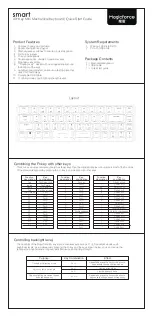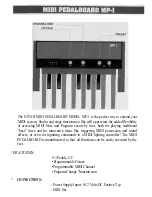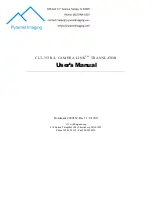
Appendix H
General MIDI
General MIDI (GM) is an addition to the original MIDI speci
fi
cation that assigns sounds to
speci
fi
c channel numbers, program numbers, and note values. The K2661’s GM Mode feature
(described in Chapter 11 of the
Musician’s Guide
) sets up your instrument for GM in a single step.
Using General MIDI, you can share song
fi
les between different devices with reasonably
consistent performance.
Many GM song
fi
les are commercially available, and they’ll sound great on your K2661.
Inside GM Mode
Here’s what happens when you enable GM Mode from the Master Page:
•
On all channels except channel 10 (which GM uses for drums), you will see only the 128 GM
programs. On MIDI channel 10, you will see the eight drum kits.
•
The K2661 will modify the following entries in the master table:
• FX mode (GM uses Master mode)
• FX channel (GM uses None)
• FX studio (GM uses the studio selected in GM Studio set on the Master: GM page)
• Receive velocity map (GM uses the GM Receive Velocity Map)
• progChgType (GM uses 0-127 mode)
Old settings will be remembered, however, so that when you turn GM Mode off the K2661
will restore your previous settings.
•
Volume and expression controllers are mapped to a special GM curve, as in “GS” synths.
(GS is a superset of General MIDI that is used by the Roland Sound Canvas and other
products.)
•
GM drum kits are mapped across program number space as in the “GS” synths, and have
exclusive zones included with them.
•
Program changes sent to the K2661 when it is in GM Mode will only select programs from
the GM program set.
Setups, Songs, and QA Banks created outside of GM Mode will not point to the correct programs within
GM Mode (although you may
fi
nd the results “interesting”). Similarly, Setups, Songs, and QA Banks
created within GM Mode will not point to the correct programs when you leave GM Mode. For this
reason, when you create Setups, Songs, or QA Banks within GM Mode you may want to append the
letters “GM” to the object’s name and/or store the objects only in certain banks.
Summary of Contents for K2661
Page 18: ...2 4 LFOs LFO Shapes...
Page 34: ...3 16 DSP Algorithms...
Page 54: ...5 4 MIDI Note Numbers Note Numbers for Percussion Keymaps...
Page 72: ...7 10 System Exclusive Protocol K2661 System Exclusive Implementation...
Page 82: ...9 4 Upgrading Sample Memory Choosing and Installing a SIMM for K2661 Sample Memory...
Page 334: ...10 252 KDFX Reference KDFX Algorithm Specifications...
Page 340: ...11 6 Glossary...
Page 382: ...12 42 Triple Modular Processing Alphanumeric Buttonpad Entries for DSP Functions...
Page 392: ...B 6 SysEx Control of KDFX MSB and LSB...
Page 442: ...D 20 Contemporary ROM Block Objects Controller Assignments Contemporary ROM Block...
Page 490: ...H 12 General MIDI Standard Mode Controller Assignments...
Page 492: ...I 2 Live Mode Objects Live Mode Programs...
Page 498: ...K2661 Musician s Reference Index...
Page 500: ......
















































